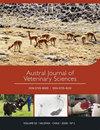智利竞技场上牡马的麻醉
IF 0.8
4区 农林科学
Q3 VETERINARY SCIENCES
引用次数: 2
摘要
摘要:本研究的目的是:a)确定阉割的频率、年龄和原因,b)确定最频繁切除的睾丸,c)比较单侧阉割和完整智利牛仔竞技种马的运动表现。对参加2016年智利牛仔竞技资格赛和全国锦标赛(CRNC)的216匹智利种马进行了评估。主人和/或骑手被询问了年龄、下倾、下倾时的年龄、切除的睾丸、下倾的原因以及下倾对种马运动成绩的影响。统计分析是描述性的,结果用平均值和百分比表示。卡方检验用于比较单侧阉割和完整种马的表现。根据CRNC的资格和最终参加冠军系列赛的情况,成绩合格。其中单侧去势种马占53%(左睾丸47%,右睾丸53%)(P>0.05),平均去势年龄为6.97±2.24岁。据报道,偏头痛的主要原因是:创伤性(76%)、体积增加(13%)和预防性(11%),但并非所有这些都有医学证实。七名车主或骑手没有意识到半昏迷的原因。46%的CRNC合格种马(P>0.05)和29%的冠军系列合格种马被单方面阉割(P=0.0122)。得出的结论是,2016年智利精英种马中有一半在开始体育活动的年龄后被单方面阉割,而不喜欢睾丸。智利牛仔竞技种马43.5%的半痉挛是预防性的,或者是基于对主人和骑手的主观评估,而没有兽医诊断,然而,尚不清楚在这些情况下半痉挛是否会影响运动表现。本文章由计算机程序翻译,如有差异,请以英文原文为准。
Hemicastration in Chilean rodeo stallions in competition
Abstract: The objectives of this study were: a) establish the frequency, age and reason for hemicastration, b) determine the most frequently removed testicle and c) compare the athletic performance between unilaterally castrated and intact Chilean rodeo stallions. Two hundred and sixteen Chilean Horse stallions participating in the 2016 Chilean rodeo qualifying rounds and National Championship (CRNC) were evaluated. Owners and/or riders were interrogated about age, hemicastration, age at hemicastration, removed testicle, reason and effects of hemicastration on athletic performance of stallions. The statistical analysis was descriptive and the results were expressed in means and percentages. Chi-square test was used to compare the performance between unilaterally castrated and intact stallions. Performance was qualified based on qualification to the CRNC and ultimately participation in the Champion series. Fifty-three percent of the stallions were unilaterally castrated (47% left testicle; 53% right testicle) (P>0.05). Mean age of hemicastration was 6.97±2.24 years. Main reasons reported for hemicastration were: traumatic (76%), increased volume (13%) and preventive (11%), but not all of them with medical confirmation. Seven owners or riders were unaware of the reason of hemicastration. Forty-six percent of the qualified stallions to the CRNC (P>0.05) and 29% of the qualified to the Champion series were unilaterally castrated (P=0.0122). It was concluded that half of the 2016 elite Chilean Horse stallions were unilaterally castrated, without preference for a testicle, after the age of initiation of sporting activity. A 43.5% of hemicastration in Chilean rodeo stallions are performed preventively or based on subjective assessments of owners and riders without veterinary diagnosis, however, it is unclear that hemicastration affected the athletic performance in these cases.
求助全文
通过发布文献求助,成功后即可免费获取论文全文。
去求助
来源期刊

Austral Journal of Veterinary Sciences
Veterinary-General Veterinary
CiteScore
1.60
自引率
0.00%
发文量
18
期刊介绍:
Austral Journal of Veterinary Sciences (formerly Archivos de Medicina Veterinaria) publishes original scientific contributions in English, containing the latest developments and discoveries in veterinary sciences. The journal covers topics such as animal health and production, preventive medicine, zoonosis, pharmacology and therapeutics, methods of diagnosis, and other areas related to the veterinary field.
Austral Journal of Veterinary Sciences aims to divulge information about advances in veterinary medicine among universities, research centres, industries, government agencies, biologists, agronomists and veterinarians.
 求助内容:
求助内容: 应助结果提醒方式:
应助结果提醒方式:


